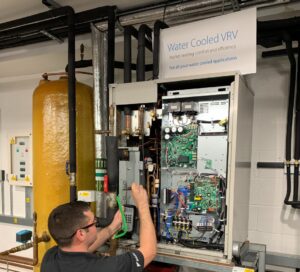A chemical process that takes carbon dioxide pollution from manufacturing plants and converts it into liquid fuel has been created by researchers at Wake Forest University, North Carolina.
This carbon-neutral process does in a lab what trees do in nature, it converts carbon dioxide into useful chemicals or fuels.
The process uses silver disopsphide as a catalyst to convert the carbon-dioxide into a material called syngas, from which a liquid fuel is made.
According to the researchers, silver is the best catalyst for this process because it reduces energy waste, this conversion process has minimal energy loss when compared to other processes.
Scott Geyer, the corresponding author of the paper said: ‘This catalyst makes the process much more efficient and silver diphosphide is the key that makes all the other parts work.
‘People make syngas out of coal all the time, but we’re taking something you don’t want, carbon dioxide pollution, and turning it into something you do want, fuel for industry.
‘The ability to collaborate with a network of outstanding Wake Forest Univerity graduates who are now at top universities and national laboratories across the United States has been essential in preparing this work as it allows us to access one-of-a-kind instrumentation facilities at their current institutions.’
In related news, bacteria that grows in seawater could be used to create renewable biofuels, according to researchers at the University of Manchester.
The scientists have discovered that a bacteria species called Halomonas, which grows in seawater, can be engineered to make high-value compounds and can then be used as a renewable biofuel.
This means that products like bio-based jet fuels could be made economically using production methods similar to those in the brewing industry and using renewable resources.
Photo Credit – Pixabay
















